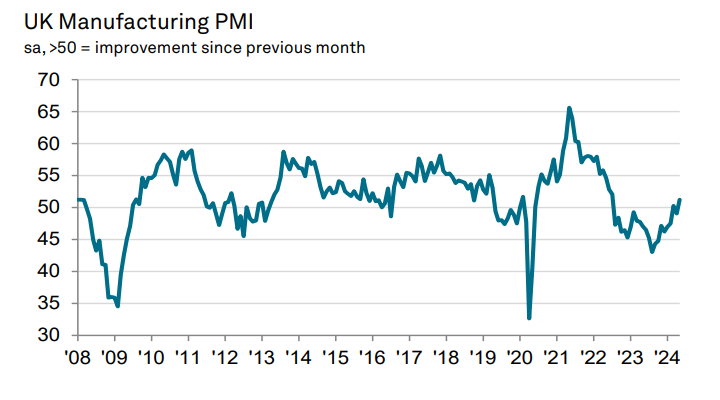Manufacturing activity jumps to highest level in over two years

Output in the UK’s manufacturing sector expanded at the fastest pace in over two years in May, a new survey shows, but cost pressures will continue to cause concerns for policymakers at the Bank of England.
S&P’s purchasing managers’ index (PMI) for the manufacturing sector rose to 51.2 in May, up from 49.1 in April. PMIs measure business activity in the private sector. Any reading above 50 indicates expansion.
The survey showed the upturn in activity was broad-based by both sub-sector and company size.
Firms reported receiving greater intakes of new work thanks to stronger market conditions and trying to complete existing contracts, both of which contributed to output growth.
“May saw a solid revival of activity in the UK manufacturing sector, with levels of production and new business both rising at the quickest rates since early-2022,” Rob Dobson, Director at S&P Global Market Intelligence, said.

Business confidence improved alongside better market conditions, with firms reporting the highest degree of optimism about the year ahead since February 2022.
“Positive sentiment was linked to hopes that continued economic recovery, promotional efforts and improved export orders would all support growth in the future,” the survey noted.
The upturn in demand was centred around the domestic market as new export orders fell for the 28th consecutive month. Orders from both the US and the EU, Germany and Poland in particular, dropped again.
The manufacturing sector has endured a torrid couple of years as firms struggled with supply chain disruptions in the wake of the pandemic and changing patterns of global demand.
While there was encouraging news on the output side, the survey showed inflationary pressures remained elevated. Input prices continued rising in May, although at a slower pace than in April.
This meant output price inflation hit its highest level in a year. Rates of increase accelerated in the consumer and intermediate goods sectors, but eased at investment goods producers.
Rate-setters at the Bank of England are looking for decisive signs that inflationary pressures are under control before cutting interest rates.
Dobson, however, suggested that easing input pressures should keep a lid on price increases. “A solid easing in the rate of increase in input costs should help prevent price pressures from becoming embedded,” he said.